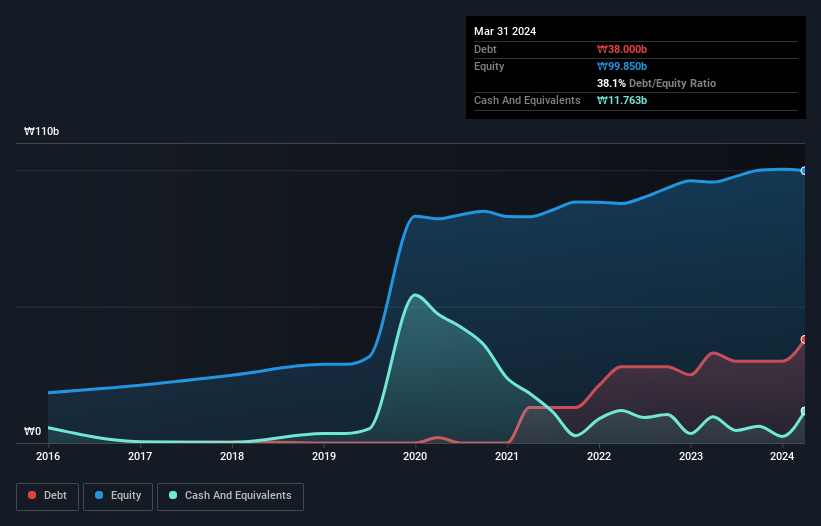- South Korea
- /
- Personal Products
- /
- KOSDAQ:A234690
Is GREEN CROSS WellBeing (KOSDAQ:234690) Using Too Much Debt?

Howard Marks put it nicely when he said that, rather than worrying about share price volatility, 'The possibility of permanent loss is the risk I worry about... and every practical investor I know worries about.' It's only natural to consider a company's balance sheet when you examine how risky it is, since debt is often involved when a business collapses. We note that GREEN CROSS WellBeing Corporation (KOSDAQ:234690) does have debt on its balance sheet. But should shareholders be worried about its use of debt?
When Is Debt A Problem?
Debt is a tool to help businesses grow, but if a business is incapable of paying off its lenders, then it exists at their mercy. Ultimately, if the company can't fulfill its legal obligations to repay debt, shareholders could walk away with nothing. While that is not too common, we often do see indebted companies permanently diluting shareholders because lenders force them to raise capital at a distressed price. Of course, debt can be an important tool in businesses, particularly capital heavy businesses. When we examine debt levels, we first consider both cash and debt levels, together.
See our latest analysis for GREEN CROSS WellBeing
How Much Debt Does GREEN CROSS WellBeing Carry?
You can click the graphic below for the historical numbers, but it shows that as of March 2024 GREEN CROSS WellBeing had ₩38.0b of debt, an increase on ₩33.0b, over one year. However, because it has a cash reserve of ₩11.8b, its net debt is less, at about ₩26.2b.

How Healthy Is GREEN CROSS WellBeing's Balance Sheet?
We can see from the most recent balance sheet that GREEN CROSS WellBeing had liabilities of ₩57.5b falling due within a year, and liabilities of ₩6.49b due beyond that. Offsetting these obligations, it had cash of ₩11.8b as well as receivables valued at ₩22.3b due within 12 months. So its liabilities outweigh the sum of its cash and (near-term) receivables by ₩29.9b.
Given GREEN CROSS WellBeing has a market capitalization of ₩172.4b, it's hard to believe these liabilities pose much threat. However, we do think it is worth keeping an eye on its balance sheet strength, as it may change over time.
We use two main ratios to inform us about debt levels relative to earnings. The first is net debt divided by earnings before interest, tax, depreciation, and amortization (EBITDA), while the second is how many times its earnings before interest and tax (EBIT) covers its interest expense (or its interest cover, for short). The advantage of this approach is that we take into account both the absolute quantum of debt (with net debt to EBITDA) and the actual interest expenses associated with that debt (with its interest cover ratio).
With a debt to EBITDA ratio of 1.6, GREEN CROSS WellBeing uses debt artfully but responsibly. And the fact that its trailing twelve months of EBIT was 7.6 times its interest expenses harmonizes with that theme. Also positive, GREEN CROSS WellBeing grew its EBIT by 20% in the last year, and that should make it easier to pay down debt, going forward. The balance sheet is clearly the area to focus on when you are analysing debt. But it is GREEN CROSS WellBeing's earnings that will influence how the balance sheet holds up in the future. So when considering debt, it's definitely worth looking at the earnings trend. Click here for an interactive snapshot.
But our final consideration is also important, because a company cannot pay debt with paper profits; it needs cold hard cash. So we always check how much of that EBIT is translated into free cash flow. During the last three years, GREEN CROSS WellBeing burned a lot of cash. While that may be a result of expenditure for growth, it does make the debt far more risky.
Our View
GREEN CROSS WellBeing's conversion of EBIT to free cash flow was a real negative on this analysis, although the other factors we considered were considerably better. There's no doubt that its ability to to grow its EBIT is pretty flash. When we consider all the factors mentioned above, we do feel a bit cautious about GREEN CROSS WellBeing's use of debt. While debt does have its upside in higher potential returns, we think shareholders should definitely consider how debt levels might make the stock more risky. Above most other metrics, we think its important to track how fast earnings per share is growing, if at all. If you've also come to that realization, you're in luck, because today you can view this interactive graph of GREEN CROSS WellBeing's earnings per share history for free.
If, after all that, you're more interested in a fast growing company with a rock-solid balance sheet, then check out our list of net cash growth stocks without delay.
New: Manage All Your Stock Portfolios in One Place
We've created the ultimate portfolio companion for stock investors, and it's free.
• Connect an unlimited number of Portfolios and see your total in one currency
• Be alerted to new Warning Signs or Risks via email or mobile
• Track the Fair Value of your stocks
Have feedback on this article? Concerned about the content? Get in touch with us directly. Alternatively, email editorial-team (at) simplywallst.com.
This article by Simply Wall St is general in nature. We provide commentary based on historical data and analyst forecasts only using an unbiased methodology and our articles are not intended to be financial advice. It does not constitute a recommendation to buy or sell any stock, and does not take account of your objectives, or your financial situation. We aim to bring you long-term focused analysis driven by fundamental data. Note that our analysis may not factor in the latest price-sensitive company announcements or qualitative material. Simply Wall St has no position in any stocks mentioned.
Have feedback on this article? Concerned about the content? Get in touch with us directly. Alternatively, email editorial-team@simplywallst.com
About KOSDAQ:A234690
GREEN CROSS WellBeing
Provides personalized nutrition injections in South Korea.
Excellent balance sheet second-rate dividend payer.
Market Insights
Community Narratives



